Welcome to the Mission Nefertari resource page. Explore an interactive timeline of Ancient Egypt with a special focus on New Kingdom queens. Discover the fascinating artifacts uncovered in Queen Nefertari’s royal tomb. Be introduced to important gods of the New Kingdom. Colour illustrations that take you back to one of the most prosperous times in Ancient Egypt, the New Kingdom.
This resource page was developed based on content from the Queens of Egypt exhibition, developed by Pointe-à-Callière, Montréal Archaeology and History Complex, in collaboration with Museo Egizio (Turin, Italy), and adapted by the Canadian Museum of History.
To learn more, scroll down or click on one of the links below.
- Interactive Timeline of Ancient Egypt
- Queen Nefertari Artifact Tomb Discovery
- 3-D Virtual Tour of Queen Nefertari’s Tomb
- Prominent Gods and Goddesses in the New Kingdom
- Colouring Sheets: Queens of Egypt and Amulets
Interactive Timeline of Ancient Egypt
Explore fascinating dynasties in Ancient Egpyt. Learn about notable queens in the New Kingdom.
This map of the Nile and its fertile valley will help you as you explore the timeline. You will see many of the Egyptian cities mentioned in different time periods.
Queen Nefertari Artifact Tomb Discovery
Building a Royal Tomb: A Major Logistical Challenge
Many texts describe how work was carried out on these king-sized construction sites.
A plan was drawn up, and 40 to 120 workers were divided into two teams: Right and Left, each supervised by a foreman.
- Stonemasons dug the corridors and chambers using metal chisels and wooden mallets.
- Labourers smoothed out the walls and applied stucco.
- The draughtsman used an ancient form of plumb bob. A wooden weight was attached to a string coated with red pigment, which was snapped against the wall to create a grid pattern. This served as a guide for his outlines of people, decorations and sacred texts — here, sketched on ostraca.
- With brushes, painters applied colours, including Egyptian blue, diluted in a cup.
All this was done by the light of torches and oil lamps.
Tomb Discovery
Most tombs were looted in antiquity, but the following objects were found in Queen Nefertari’s tomb in 1904, by archaeologist Ernesto Schiaparelli (former director of the Museo Egizio).
- Mummified knees (presumably Nefertari’s, although there is no firm scientific proof).
- Sandals in fashion at the time, made of palm leaves.
- Fragments of amphorae (jugs or vases containing food and drink).
- Thirty-four shabtis (originally, there were likely hundreds).
- Lids to boxes probably used to store shabtis.
- Knob with the cartouche Ay (deceased pharaoh), suggesting that he may have been related to Nefertari, or that the knob might simply have been reused from a piece of furniture in another tomb.
- Djed pillar amulet.
- Fragment of an ibis (bird) statue.
- Fragments of a pink-granite coffin.
Although Nefertari’s tomb was largely empty when rediscovered in 1904, the beauty and vivid colours in the tomb’s paintings — depicting her journey to the afterlife — make it extraordinary.
The beauty of this tomb tells us that Ramses II loved Nefertari deeply, leading him to oversee construction of one of the most elaborate tombs ever made for a queen. This tomb reflects the prosperity and wealth of the New Kingdom, while also revealing the important role Queen Nefertari played in the life of Ramses II.
Sandals
- These sandals made of palm leaves were fashionable in Nefertari’s time.
- Nefertari is only depicted wearing sandals in the wall paintings in the antechamber of her tomb, as wearing sandals was not permitted on the holy ground of Nefertari’s actual resting place.
- Gods and goddesses never wore sandals.
Ibis Statue
- Fragment of an ibis statue.
- The ibis represents Thoth, god of wisdom and writing.
- In Nefertari’s tomb, there is a reference to Spell 94 of the Book of the Dead, in which Nefertari asks to be brought the writing kit of Thoth, because she is a scribe. While it is uncertain whether Nefertari was literate, the inclusion of this text among many other spells suggests that she was.
Shabtis
- Nefertari’s tomb contained these 34 shabtis.
- During the New Kingdom, shabtis were mass-produced in moulds. The figurines held tools, such as hoes and seed bags, to allow them to work on behalf of the deceased in the afterlife.
- Nefertari probably had 401 shabtis in her tomb: 365 worker shabtis for each day of the year, and 36 overseer shabtis.
- Each bears the queen’s name, her title, and an excerpt of the “shabti spell” from The Book of the Dead, indicating that they will take up their duties when called upon.
Translation of the Shabti Spell
O shabti, allotted to me, if I be summoned, or if I be detailed to do any work which has to be done in the realm of the dead; if indeed obstacles are implanted for you therewith as a man at his duties, you shall detail yourself for me on every occasion of making arable the fields, of flooding the banks or of conveying sand from east to west; “Here I am,” you shall say.
Translation by R. O. Faulkner
Djed – Pillar Amulet
- Nefertari’s name and title appear on the back of this djed pillar amulet representing the spine of Osiris.
- Osiris was the ruler of the Underworld and judge of the dead. He promised justice in the Afterlife, and survival of the spirit after death.
- This djed would have stood on one of four protective bricks (now missing) placed in each corner of the burial chamber.
- According to The Book of the Dead, a spell had to be “said over a djed pillar amulet of faïence, with a top covered with electrum [gold/silver alloy] and royal linen, anointed with oil and set firmly on an unbaked clay brick.”
- The djed was also worn by many Egyptians in the New Kingdom. It was thought to give the wearer the protection, endurance and stability of Osiris.
Fragments of Nefertari’s Sarcophagus
- The sarcophagus, made of pink granite, was carved for Queen Nefertari.
- The word “sarcophagus” comes from the Greek, and means “flesh-eater,” because a limestone sarcophagus can cause the rapid breakdown of a body.
- A royal sarcophagus is usually made of stone, and is the outer layer of protection for a mummy. Granite was an especially expensive stone, and was reserved for royal burials.
- Inside the sarcophagus was a coffin made of wood or metal.
- The coffin itself had many layers to help protect its contents, which included precious amulets, scarabs and the mummy itself. Nefertari’s coffin most likely contained a coffin lid, a false lid placed over the mummy for extra protection, and an outer coffin. It has been likened to a Russian doll, with cases of decreasing size placed one inside the other.
- By protecting the body, the coffin and sarcophagus allowed the deceased to accompany the Sun god into the Afterlife.
- This is all that is left of Nefertari’s sarcophagus and coffins, which were looted and broken in antiquity.
3-D Virtual Tour of Queen Nefertari’s Tomb
Feast your eyes on the splendour of Queen Nefertari’s tomb, rediscovered in 1904 by archaeologist Ernesto Schiaparelli — former director of Italy’s Museo Egizio. This dazzling 3D re-creation of Nefertari’s tomb was developed by Andrey Plaksin.
Use your mouse to click, zoom and explore at your own pace. Queen Nefertari is depicted in the various chambers of her tomb. Can you find her? The spectacular paintings lining the walls show her on her journey to the Afterlife.
3D virtual tour created and provided by Andrey Plaksin – www.nefertaritomb.com.
The interface is available in English only.
Prominent Gods and Goddesses in the New Kingdom
Learn more about the notable gods and goddesses on the walls in Queen Nefertari’s tomb.
Osiris
- The name Osiris means “mighty and powerful.”
- Osiris is considered to have been the first pharaoh.
- He is ruler of the Underworld and judge of the dead.
- Osiris represents the promise of justice in the Afterlife, and survival of the spirit after death.
- His skin is green or black, symbolizing resurrection and fertility as reflected in the annual flooding of the Nile.
- He holds two objects known as a “crook” and a “flail,” symbolizing his divine authority.
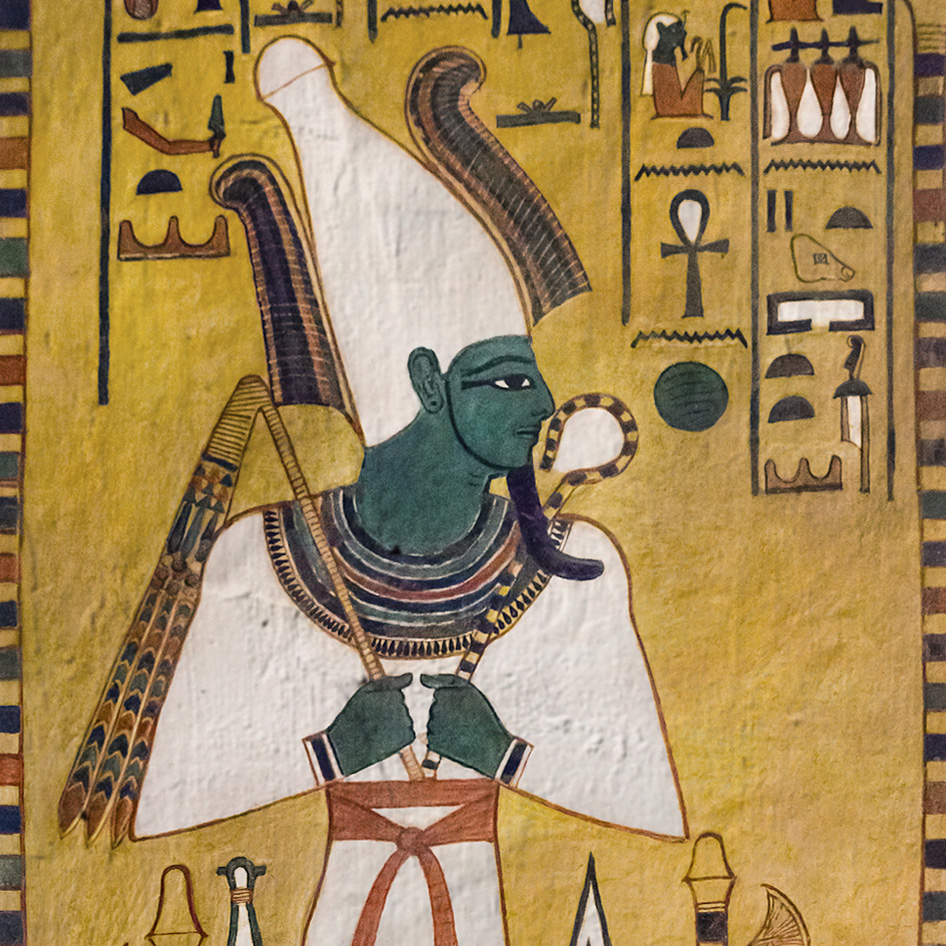
Andrey Plaskin, www.nefertaritomb.com
 Queen Nefertari’s Tomb – OsirisAndrey Plaskin, www.nefertaritomb.com
Queen Nefertari’s Tomb – OsirisAndrey Plaskin, www.nefertaritomb.com
Isis
- Isis is the goddess of magic, death, healing and rebirth.
- She is said to have made the very first mummy.
- She is the wife and sister of Osiris, and the mother of Horus.
- The role of the queen can be symbolized by Isis. A queen must protect the king and produce the rightful heir.
- Isis wears the hieroglyphic sign of the throne on her head.

Andrey Plaskin, www.nefertaritomb.com
 Queen Nefertari’s Tomb – IsisAndrey Plaskin, www.nefertaritomb.com
Queen Nefertari’s Tomb – IsisAndrey Plaskin, www.nefertaritomb.com
Anubis
- Anubis is known as the protector of the dead.
- He is depicted as a jackal or a jackal-headed man.
- He is closely associated with mummification, and is known as the god of embalming.
- He is said to have built Egypt’s first tombs.
- Anubis was regularly called upon for both protection and revenge.
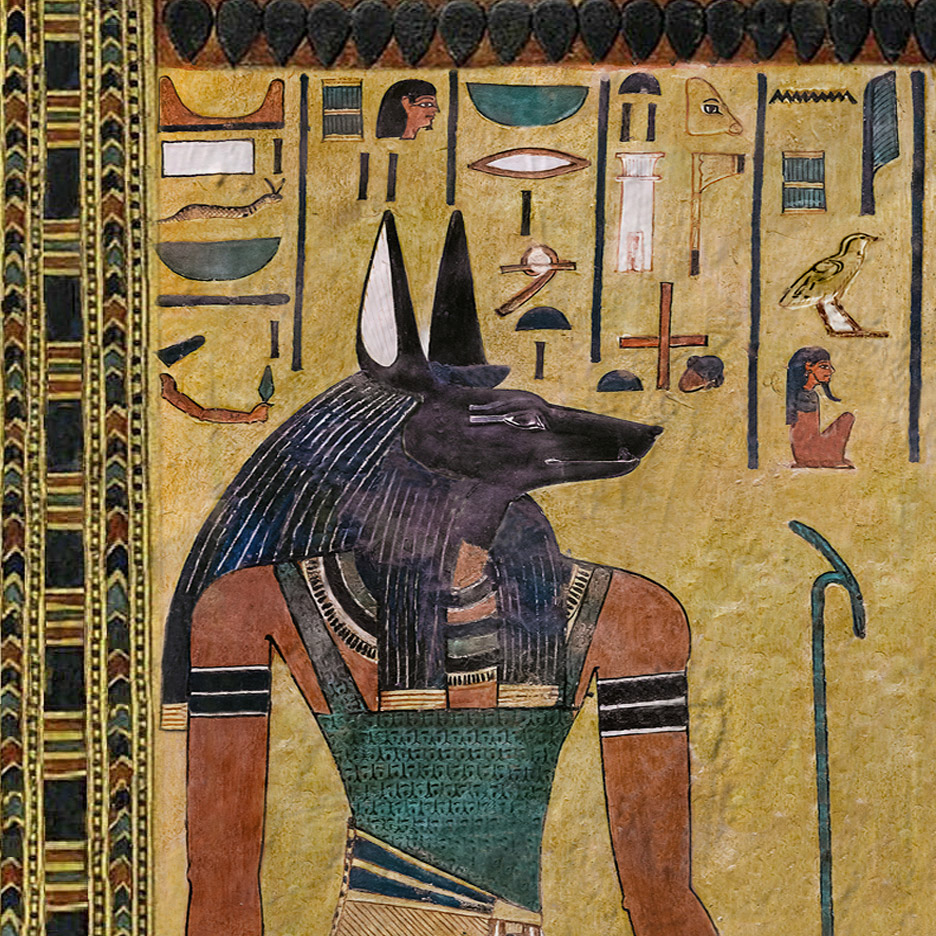
Andrey Plaskin, www.nefertaritomb.com
 Queen Nefertari’s Tomb – AnubisAndrey Plaskin, www.nefertaritomb.com
Queen Nefertari’s Tomb – AnubisAndrey Plaskin, www.nefertaritomb.com
Hathor
- Hathor is the goddess of women, fertility and love.
- Her name means “the house of Horus,” referring to the sky.
- She is the wife of Horus.
- The animal form of Hathor is a heavenly cow.
- It is sometimes believed that all other Egyptian goddesses were forms of Hathor.
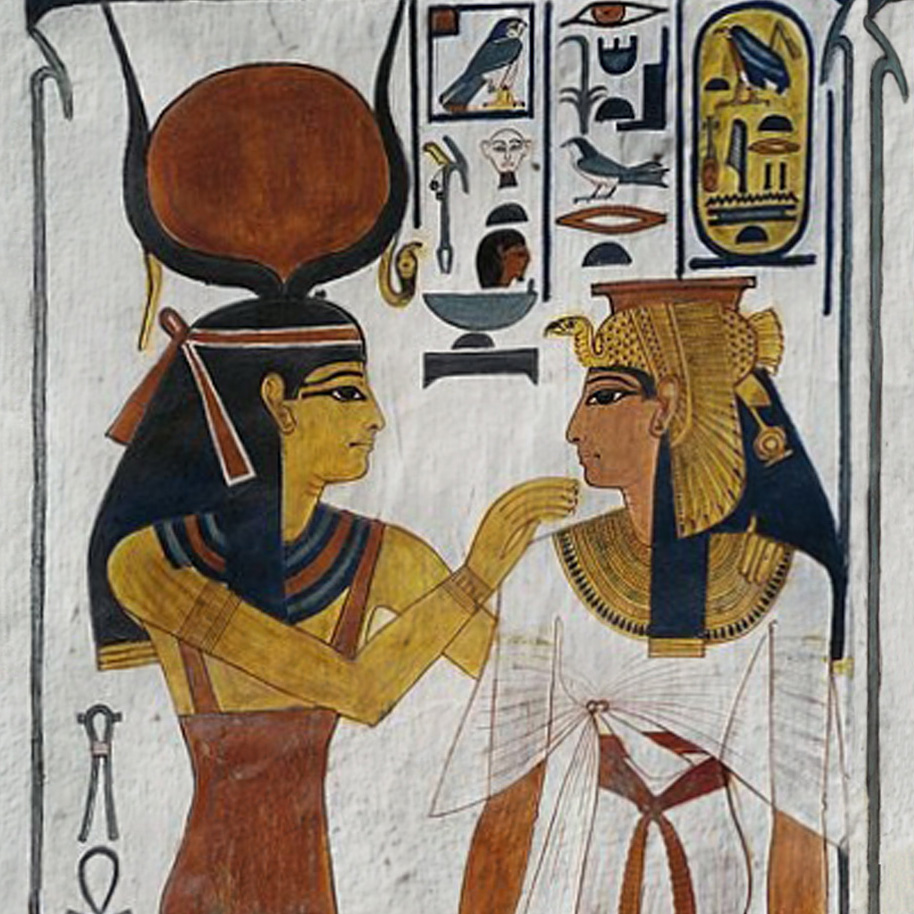
Andrey Plaskin, www.nefertaritomb.com
 Queen Nefertari’s Tomb – HathorAndrey Plaskin, www.nefertaritomb.com
Queen Nefertari’s Tomb – HathorAndrey Plaskin, www.nefertaritomb.com
Horus
- Horus was the god of kingship and the sky.
- Horus is viewed as the protector of the ruler of Egypt.
- The most important animal form of Horus is a falcon.
- Egyptians believed that the pharaoh was the living incarnation of Horus.
- Horus is usually depicted wearing a double crown.

Andrey Plaskin, www.nefertaritomb.com
 Queen Nefertari’s Tomb – HorusAndrey Plaskin, www.nefertaritomb.com
Queen Nefertari’s Tomb – HorusAndrey Plaskin, www.nefertaritomb.com
Thoth
- Thoth is the god of writing and knowledge.
- He is the inventor of hieroglyphs.
- He is depicted as a man with the head of an ibis.
- He recorded the deeds of the dead on the day of their judgement.
- He is portrayed as a mediator between gods.
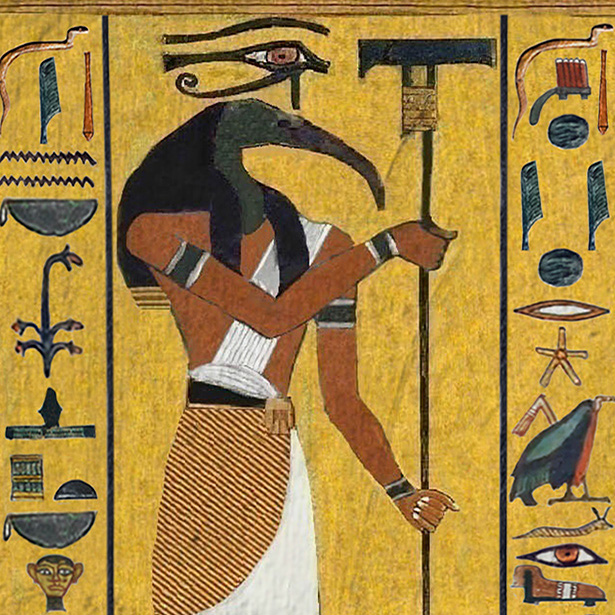
Andrey Plaskin, www.nefertaritomb.com
 Queen Nefertari’s Tomb – ThothAndrey Plaskin, www.nefertaritomb.com
Queen Nefertari’s Tomb – ThothAndrey Plaskin, www.nefertaritomb.com
Maat
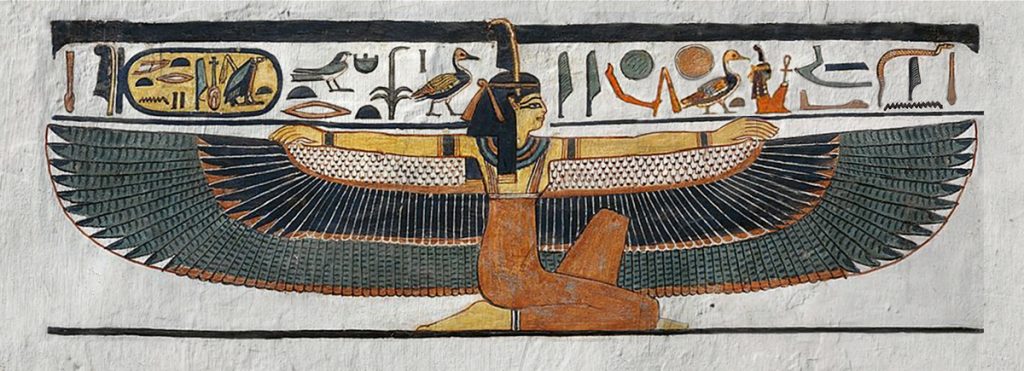
Andrey Plaskin, www.nefertaritomb.com
- Maat was the goddess of truth and justice.
- She represents divine order.
- She controls the seasons and the movements of stars.
- She is depicted wearing an ostrich feather, and sometimes appears as a winged goddess.
- The heart of the deceased was weighed against her feather.
 Queen Nefertari’s Tomb – MaatAndrey Plaskin, www.nefertaritomb.com
Queen Nefertari’s Tomb – MaatAndrey Plaskin, www.nefertaritomb.com
Khepri-Re
- Khepri-Re is the god of creation, the movement of the sun, life and resurrection.
- His name means, “He who is coming into being.”
- He is depicted as a scarab beetle, or as a man with a scarab for a head.
- A scarab representation of Khepri-Re was by far the most important amulet.
- The scarab was an earthly symbol of the heavenly cycle.
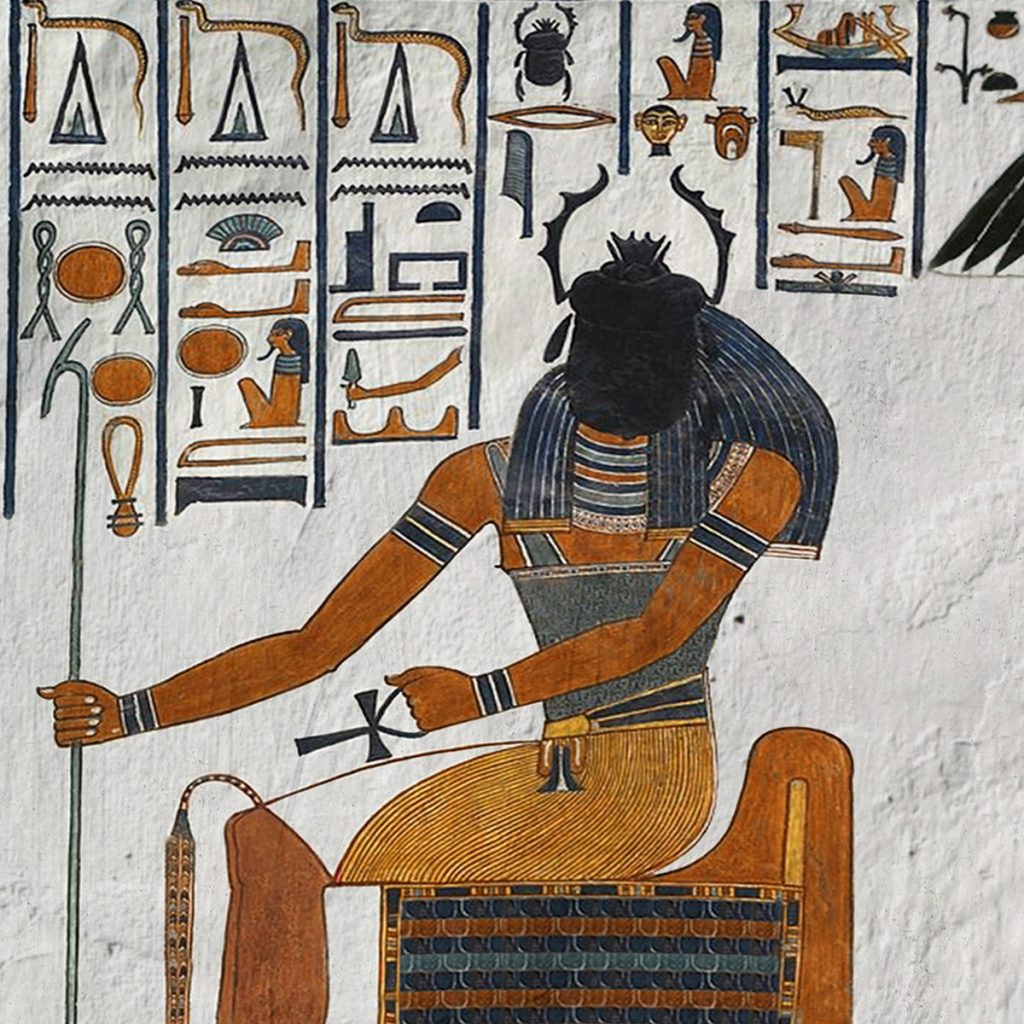
Andrey Plaskin, www.nefertaritomb.com
 Queen Nefertari’s Tomb – Khepri-ReAndrey Plaskin, www.nefertaritomb.com
Queen Nefertari’s Tomb – Khepri-ReAndrey Plaskin, www.nefertaritomb.com
Nekhbet

Andrey Plaskin, www.nefertaritomb.com
- Nekhbet was the vulture goddess and protector of Egypt. Although the patron of Upper Egypt, she was venerated in both regions.
- Nekhbet flew through the entire Nile Valley, and her headdress was worn by queens at both Memphis and Thebes.
- A vulture was the first insignia to be associated with queens. The word for mother was written with a hieroglyph representing a vulture.
- When a vulture’s chicks are threatened, the female bird will extend her wings to make herself look larger and frighten away predators.
 Queen Nefertari’s Tomb – NekhbetAndrey Plaskin, www.nefertaritomb.com
Queen Nefertari’s Tomb – NekhbetAndrey Plaskin, www.nefertaritomb.com
Wadjet

Andrey Plaskin, www.nefertaritomb.com
- Wadjet was the cobra goddess and protector of Egypt. Although she was a patron of Lower Egypt, she was venerated in both regions. Her symbols is the uraeus (rearing cobra).
- The uraeus was an important symbol worn by pharaohs and queens to protect Egypt.
- Wadjet can mean the “fresh one” or the “green one.”
- She represents regeneration, strength and freshness. She is also a deadly venomous snake able to protect the king from his enemies. Any goddess can take the form of a snake, and a snake can be used as shorthand for the words “goddess” or “queen.”
 Queen Nefertari’s Tomb – WadjetAndrey Plaskin, www.nefertaritomb.com
Queen Nefertari’s Tomb – WadjetAndrey Plaskin, www.nefertaritomb.com
Colouring Sheets: Queens of Egypt and Amulets
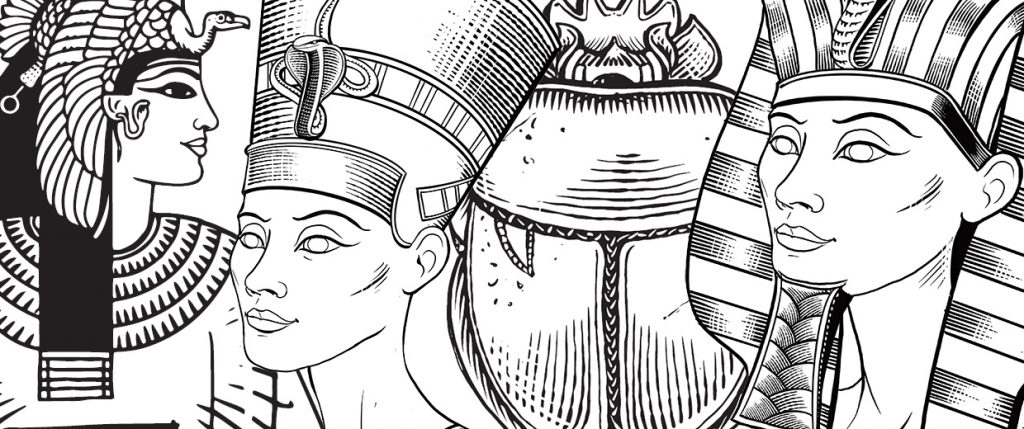
Use your creativity and imagination to colour in ancient animals, royal crowns and amulets.
Photo at top of page:
© Assassin’s Creed, Ubisoft Montréal / © Pointe-à-Callière, Queens of Egypt Concept.
© Museo Egizio, Turin, Italy.













